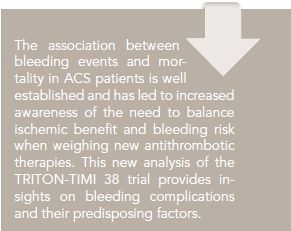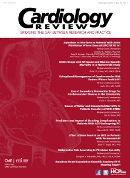Publication
Article
Cardiology Review® Online
Predictors and Impact of Bleeding Complications in Patients With ACS Undergoing PCI
Author(s):

Marco Roffi, FES C, FA CC
REVIEW
Hochholzer W, Wiviott DS, Antman EM, et al. Predictors of bleeding and time dependence of association of bleeding with mortality: insights from the Trial to Assess Improvement in Therapeutic Outcomes by Optimizing Platelet Inhibition with Prasugrel-Thrombolysis in Myocardial Infarction 38 (TRITON-TIMI 38). Circulation. 2011;123:2681-2689.

T
he association between bleeding events and late mortality in patients with ACS is well established. 1 This observation has led to increased awareness of balancing ischemic benefit and bleeding risk in the assessment of new antithrombotic therapies. Prasugrel is a P2Y12 inhibitor that is more potent than clopidogrel and virtually abolishes the individual variability in the response to antiplatelet therapy observed with clopidogrel. Prasugrel has received a Class I indication in both the American and European ACS 2011 guidelines.2,3
This new analysis of the TRITONTIMI 38 trial focusing on bleeding complications confirms the major impact of serious bleeding on mortality and provides insights on the type of bleeding complications that occurred in the trial and their predisposing factors. 4
Study Details
The TRITON-TIMI 38 study randomized 13,608 patients with moderate- to high-risk acute coronary syndromes (ACS), both ST-elevation myocardial infarction (STEMI) and non-ST-elevation ACS, to aspirin and prasugrel (a 60-mg loading dose and a 10-mg/d maintenance dose) versus aspirin and clopidogrel (a 300-mg loading dose and a 75-mg/d maintenance dose).5 All patients were scheduled for percutaneous coronary intervention (PCI). Major clinical events were assessed at a mean follow-up of 14.5 months.
The primary efficacy end point was death from cardiovascular causes, nonfatal myocardial infarction (MI), or nonfatal stroke. The key safety end point was major bleeding. The primary efficacy end point occurred in 12.1% of patients receiving clopidogrel and 9.9% of patients receiving prasugrel (hazard ratio [HR] for prasugrel vs clopidogrel, 0.81; 95% confidence interval [CI], 0.73-0.90; P <0.001). There was also a significant reduction in the prasugrel group in the rates of MI (9.7% for clopidogrel vs 7.4% for prasugrel; P <0.001), urgent target- vessel revascularization (3.7% vs 2.5%; P <0.001), and stent thrombosis (2.4% vs 1.1%; P <0.001). Major bleeding was observed in 2.4% of patients receiving prasugrel and in 1.8% of patients receiving clopidogrel (HR, 1.32; 95% CI, 1.03-1.68; P = 0.03). The rate of life-threatening bleeding was also greater in the prasugrel group (1.4% vs 0.9%; P = 0.01), including nonfatal bleeding (1.1% vs 0.9%; HR, 1.25; P = 0.23) and fatal bleeding (0.4% vs 0.1%; P = 0.002).
The aim of the current analysis,4 which included 13,420 patients, was to identify baseline characteristics that independently predicted bleeding events and to determine how bleeding events impacted mortality in the TRITON-TIMI 38 trial. A total of 534 patients (4.0%) experienced a serious bleeding event. The variables with the highest strength of association with a serious bleeding event included female sex (HR, 1.77), the use of glycoprotein IIb/IIIa receptor inhibitor (HR, 1.59), duration of intervention, age, assignment to prasugrel (HR, 1.34) admission diagnosis of STEMI (HR, 1.35), femoral access for angiography and intervention (HR, 1.60), creatinine clearance, hypercholesterolemia, and arterial hypertension.
Fatal serious bleeding occurred in 21 patients (0.3%) treated with prasugrel and in 6 patients (0.1%) treated with clopidogrel (HR, 3.50; 95% CI, 1.41- 8.68; P = 0.01). This excess of serious bleeding on prasugrel occurred in both instrumented/traumatic and spontaneous bleeding, and was driven mainly by a higher incidence of bleeding from surgical sites (other than coronary artery bypass grafting [CABG]) (HR, 5.05; 95% CI, 1.46-17.45; P = 0.01) and gastrointestinal bleeding (HR, 1.32; 95% CI, 0.99-1.77; P = 0.05). Transfusions related to bleeding were more frequent in patients assigned to prasugrel (HR, 1.33; 95% CI, 1.07- 1.67; P = 0.01). Minimal bleeding was also more frequent in patients assigned to prasugrel (HR, 1.48; 95% CI, 1.29-1.71; P <0.001), largely related to puncture site bleeding and epistaxis. No differences were detected in the 2 groups with respect to intracranial bleeding (numerically higher in the clopidogrel group) and access side bleeding (numerically higher in the prasugrel group).
Subgroups of patients with higher risk of serious bleeding were identified— namely, patients with a history of stroke or transient ischemic attack (TIA) (HR, 1.58; 95% CI, 1.10-2.29; P = 0.01), age ≥75 years (HR, 2.58; 95% CI, 2.13-3.13; P <0.001), and body weight <60 kg (HR, 2.30; 95% CI, 1.74-3.05; P <0.001).
In patients with a history of stroke or TIA, the increased rate of serious bleeding was driven mainly by a higher rate of intracranial bleeding events (6 of 20 serious bleeding events with prasugrel). Serious bleeding was significantly associated with mortality (adjusted HR, 5.84).
However, according to the analyses performed, the impact of instrumented or traumatic serious bleeding on mortality was of short duration (ie, less than a week). Serious spontaneous bleeding tended to have a longer impact on mortality, with an HR significantly elevated for approximately 1 month but becoming nonsignificant thereafter.
The authors summarized the results of this analysis with 5 major findings:
(1) Only a limited number of variables were found to be independently associated with serious bleeding in the entire cohort. Those most strongly associated with the risk of bleeding were female sex and advanced age, together with procedural characteristics.
(2) Although prasugrel was independently associated with a higher risk of serious bleeding than clopidogrel, the strength of this association was less than the above-named clinical factors.
(3) Assignment to prasugrel was principally associated with a higher frequency of serious gastrointestinal bleeding, bleeding at surgical sites, and more frequent non-serious nasal and vascular access site bleeding.
(4) Blood transfusion for bleeding was not an independent predictor for mortality after full adjustment for all available variables and bleeding.
(5) The impact of bleeding events on mortality was greatest within the first few days. However, its impact on mortality waned rapidly and the HR was not significantly different from 1.0 after 40 days.
References
1. Eikelboom JW, Mehta SR, Anand SS, Xie C, Fox KA, Yusuf S. Adverse impact of bleeding on prognosis in patients with acute coronary syndromes. Circulation. 2006;114:774-782.
2. Wright RS, Anderson JL, Adams CD, et al. 2011 ACCF/AHA Focused Update of the Guidelines for the Management of Patients With Unstable Angina/Non-ST-Elevation Myocardial Infarction (Updating the 2007 Guideline): a report of the American College of Cardiology Foundation/American Heart Association Task Force on Practice Guidelines. Circulation. 2011;123:2022-2060.
3. Hamm CW, Bassand JP, Agewall S, et al. ESC Guidelines for the management of acute coronary syndromes in patients presenting without persistent ST-segment elevation: the Task Force for the management of acute coronary syndromes (ACS) in patients presenting without persistent ST-segment elevation of the European Society of Cardiology (ESC) [published online ahead of print August 26, 2011]. Eur Heart J.
4. Hochholzer W, Wiviott SD, Antman EM, et al. Predictors of bleeding and time dependence of association of bleeding with mortality: insights from the Trial to Assess Improvement in Therapeutic Outcomes by Optimizing Platelet Inhibition With Prasugrel-- Thrombolysis in Myocardial Infarction 38 (TRITON-TIMI 38). Circulation. 2011;123(23):2681-2689.
5. Wiviott SD, Braunwald E, McCabe CH, et al. Prasugrel versus clopidogrel in patients with acute coronary syndromes. N Engl J Med. 2007;357:2001-2015.
6. Jolly SS, Yusuf S, Cairns J, et al. Radial versus femoral access for coronary angiography and intervention in patients with acute coronary syndromes (RIVAL): a randomised, parallel group, multicentre trial. Lancet. 2011;377:1409-1420.
7. Wallentin L, Becker RC, Budaj A, et al. Ticagrelor versus clopidogrel in patients with acute coronary syndromes. N Engl J Med. 2009;361:1045-1057.
8. Chin CT, Roe MT, Fox KA, et al. Study design and rationale of a comparison of prasugrel and clopidogrel in medically managed patients with unstable angina/non-STsegment elevation myocardial infarction: the TaRgeted platelet Inhibition to cLarify the Optimal strateGy to medicallY manage Acute Coronary Syndromes (TRILOGY ACS) trial. Am Heart J. 2010;160:16-22 e11.
9. Montalescot G, Wiviott SD, Braunwald E, et al. Prasugrel compared with clopidogrel in patients undergoing percutaneous coronary intervention for ST-elevation myocardial infarction (TRITON-TIMI 38): doubleblind, randomised controlled trial. Lancet. 2009;373:723-731.
10. Wiviott SD, Braunwald E, Angiolillo DJ, et al. Greater clinical benefit of more intensive oral antiplatelet therapy with prasugrel in patients with diabetes mellitus in the trial to assess improvement in therapeutic outcomes by optimizing platelet inhibition with prasugrel- Thrombolysis in Myocardial Infarction 38. Circulation. 2008;118:1626-1636.
COMMENTARY
Predictiors and Impact of Bleeding Complications
T
he most impressive finding of this study is the strong association serious bleeding events have with mortality (HR, 5.84). The authors underscored the fact that the impact of serious bleeding on mortality was not more significant after 40 days. However, the clinical relevance of this observation remains limited.
This study identified independent predictors of serious bleeding, which included female sex, use of glycoprotein IIb/IIIa receptor inhibitors, duration of intervention, age, assignment to prasugrel, admission diagnosis of STEMI, femoral access for angiography, creatinine clearance, hypercholesterolemia, and arterial hypertension. With respect to prasugrel, the increased risk of bleeding was principally associated with a higher frequency of serious gastrointestinal bleeding, bleeding at surgical sites, and more frequent non-serious nasal and vascular access site bleeding. Patients in the prasugrel group received more frequent blood transfusions than those assigned to clopidogrel. However, in contrast to previous findings, in TRITONTIMI 38, blood transfusion did not independently predict mortality. How should those findings influence our clinical practice? First of all, we should be more restrictive in the administration of glycoprotein IIb/IIIa receptor inhibitors in patients treated with prasugrel. The use of those agents should be limited to patients at high ischemic risk (ie, STEMI patients with an occlusion of a major epicardial vessel and sizable thrombus burden on angiography) who at the same time are not at increased bleeding risk. Second, the use of a transradial approach should be favored in patients treated with prasugrel. The benefit of the transradial approach versus the transfemoral one in terms of reduction of access site bleeding and access site complications is now supported by a randomized trial.6 More centers in Europe have “converted” to the transradial approach. At my center, the University Hospital of Geneva, the rate of PCI by transradial approach rose from less than 5% in 2007 to 73% in 2010.
TRITON-TIMI 38 indentified 3 groups of patients with increased bleeding risk with prasugrel: patients with history of stroke or TIA, ≥75 years, and body weight <60 kg. Based on the increased rate of intracranial bleeding observed in patients with prior TIA/ stroke treated with prasugrel, the administration of the drug at 10 mg/day over several months should be considered contraindicated. For patients aged ≥75 years or with body weight <60 kg, other drugs such as ticagrelor should be considered.7 There are no clinical data yet available for prasugrel 5 mg/day; however, the efficacy and safety of this dosage is currently being investigated in the TRILOGY trial.8
It is worth remembering that for 2 main categories of patients the benefit-risk ratio of prasugrel appears particularly favorable: STEMI and diabetic patients. In STEMI, allocation to prasugrel in TRITON-TIMI 38 was associated not only with a reduction in the primary end point of cardiovascular death, MI, or stroke, but also with significant reduction in mortality in the absence of an increase in non-CABG TIMI major bleedings.9 In diabetic patients the benefit of prasugrel was impressive with respect to the primary end point (12.2% in the prasugrel group and 17.0% in the clopidogrel group; HR, 0.70; P <0.001) and no increase in non-CABG major bleeding was observed.10
About the Author
Marco Roffi, FE SC, FA CC, is associate professor of medicine and director of the Interventional Cardiology Unit at the University Hospital of Geneva, in Geneva, Switzerland. He received his Swiss board certification in internal medicine and trained in general and interventional cardiology at the University Hospital of Berne. His fellowship in coronary, peripheral, and carotid interventions was at the Cleveland Clinic. Dr Roffi is chairman of the Scientific Program Committee of the European Association of Percutaneous Cardiovascular Intervention (EAPCI) and a member of the Program Committee of EuroPCR. He has coauthored over 120 publications, 34 book chapters, and edited 3 books. His clinical and research fields of interest include ACS, anti-platelet therapy, CAD in diabetes, and carotid and peripheral interventions.
